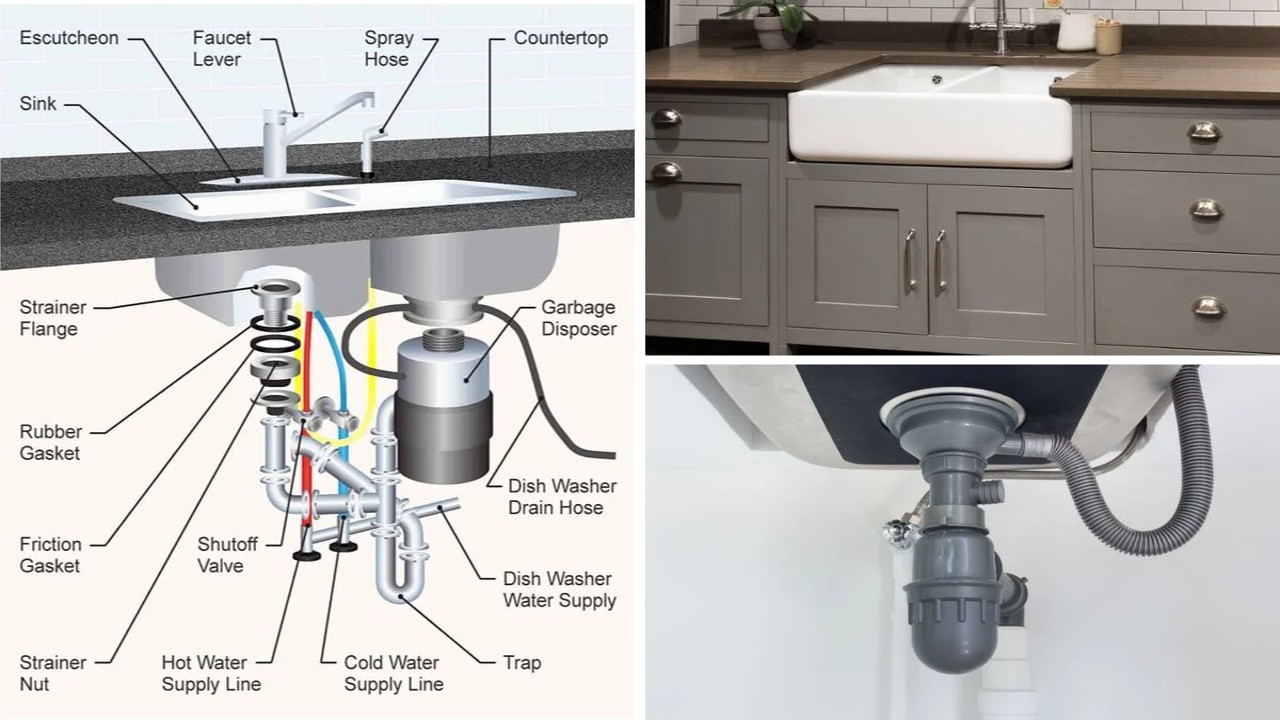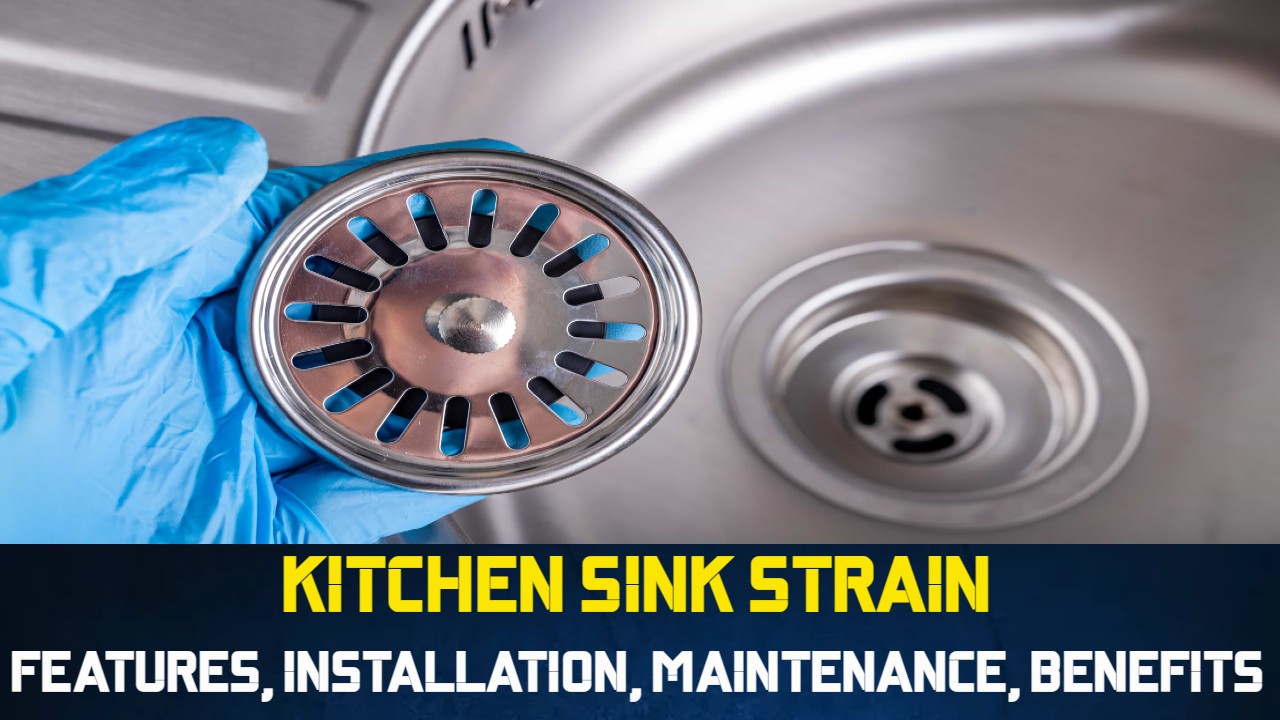The hub of your house is the kitchen, where all the culinary magic takes place. You need a dependable and adaptable kitchen sink to make cooking even more enjoyable. Introducing the kitchen sink strain, a cutting-edge feature to contemporary kitchens. The characteristics, advantages, and method of installation of the kitchen sink strain will all be covered in this article, along with the reasons why any homeowner who values convenience and use in their kitchen must have one.
What is a Kitchen Sink Strain?
To keep food particles, trash, and other solid waste from clogging your plumbing system, you may install a kitchen sink strain into the drain hole of your sink. As a filter, it lets water through freely while catching solid waste, making it simple to get rid of it afterwards.
Importance of a Kitchen Sink Strain
In order to keep your kitchen clean and functional, a kitchen sink strain is essential. You save the inconvenience and expense of dealing with plumbing problems by avoiding clogs and obstructions in your plumbing system. By lowering the quantity of food waste that gets dumped into the sewer system, it also contributes to environmental protection.
Key Features of the Kitchen Sink Strain
Efficient Filtration: The Kitchen Washbasin Strain is intended to filter away solid waste, such as food particles and dirt, in an efficient manner while enabling free water flow. It guarantees smooth drainage and keeps your plumbing system free of obstructions.
Durable Construction: High-quality materials, such as resilient silicone or stainless steel, were used in the construction of this washbasin strainer. It is designed to endure regular usage and is corrosion-resistant to provide long-lasting performance.
Easy Installation: The method of installing the kitchen sink strainer is easy and hassle-free. It normally has a universal design that works with the majority of common washbasin drains. It is simple to install on your own without assistance from an expert.
Versatile Design: The Kitchen Sink Strain is offered in a variety of shapes and sizes to meet diverse sink arrangements and individual tastes. There is a strain that works for you whether you have a single or double bowl sink.
Easy Maintenance: The Kitchen Washbasin Strain is simple to keep clean and maintained. The majority of strains are dishwasher safe and easy removable for washing. To maintain it in top shape, regular rinsing and occasional cleaning are typically adequate.
Keep in mind that the Kitchen Sink Strain offers effective waste management, durability, simple installation, adaptability, and little maintenance, making it a great addition to your kitchen.
Also Read: Lemon Kitchen Décor: Adding Zesty Charm to Your Culinary Space 2023 New!
Installation Process of a Kitchen Sink Strain
Simple measures may be followed to complete the installation of a kitchen sink strain:

Remove the Old Sink Strainer: If you already have a washbasin strainer, remove it first. Typically, you may accomplish this by removing the mounting nut from below the sink.
Clean the Drain Opening: Clean out your sink’s drain opening completely. Make sure the surface is clean before you install the new kitchen sink strainer by clearing away any debris, old putty or residue.
Apply Plumber’s Putty or Silicone Sealant: Roll a little quantity of silicone sealant or plumber’s putty into a thin, even rope. Apply this all the way around the Kitchen Sink Strain’s flange’s underside.
Insert the Strain into the Drain Opening: Make sure the Kitchen Sink Strain rests flat and firmly in the drain opening by carefully inserting it there. Putty or sealant aids in producing a waterproof seal and halting leaks.
Secure the Mounting Nut: Find the mounting nut that was included with the Kitchen Sink Strain from behind the sink. By hand, tighten the nut until it is firm against the sink’s bottom. To finish tightening it, use a wrench or a pair of pliers. Avoid overtightening to avoid damaging the strain or sink.
Wipe off Excess Putty or Sealant: Clean up any surplus silicone sealant or plumber’s putty that was pushed out during installation. Remove the residue from the top and bottom of the washbasin using a clean cloth or sponge.
Test the Strain: Run water through the sink after installation to see if the Kitchen Sink Strain is successfully capturing solid waste while allowing water to flow freely. Make sure there are no leaks around the strain, and if there are, tighten the mounting nut.
All done! The kitchen sink strainer has been successfully fitted. You may now take advantage of its benefits for keeping your washbasin clean and functioning and preventing blockages. To get the greatest installation results, always adhere to the manufacturer’s instructions that are particular to your kitchen sink strainer.
How to Maintain a Kitchen Sink Strain
You should adhere to the following maintenance advice to maintain your kitchen sink strain in top condition:
- Regularly remove and dispose of trapped solid waste.
- Rinse the strain with warm water after each use.
- Use a mild detergent and a soft brush to remove any stubborn residue.
- Avoid using harsh chemicals or abrasive cleaners that can damage the strain’s surface.
- Check and tighten any loose mounting parts periodically.
Benefits of Using a Kitchen Sink Strain
There are various advantages to using a kitchen sink strainer that improve your culinary experience:
Prevents Clogs: One of the main advantages of employing a kitchen sink strainer is that it aids in the prevention of plumbing system obstructions. The strain prevents solid waste like food scraps and dirt from entering the pipes, providing efficient drainage and lowering the possibility of clogs.
Maintains Cleanliness: The kitchen sink strainer is essential for keeping your sink clean and for preventing bad odours. It maintains a clean sink and a fresh-smelling kitchen by capturing food particles and other trash.
Protects the Plumbing System: The Kitchen Washbasin Strain helps shield your plumbing system from harm by preventing blockages. Pipe blockages, leaks, and other plumbing problems caused by clogs may necessitate expensive repairs. In the long term, using a strain can help you save time, money, and frustration.
Eco-Friendly: Making use of a kitchen sink strainer is a sustainable decision. It lessens the quantity of food waste that is disposed of in landfills or sewage systems. You may efficiently separate solid trash from the water supply by collecting it, which encourages more environmentally friendly waste disposal techniques.
Easy to Clean: It’s simple to clean the kitchen sink strainer. The majority of strains are created for simple removal, making it simple to get rid of trash that has been caught. Furthermore, many strains are dishwasher-safe, which makes cleaning even easier.
Cost-Effective: Long-term financial savings are possible if you get a kitchen sink strainer. You may minimise the need for pricey repairs or expert plumbing services by avoiding blockages and minimising plumbing problems. It is an affordable option that increases the durability of your plumbing system.
Versatile and Compatible: Kitchen sink strainers are adaptable with many sink arrangements since they come in a variety of sizes and styles. There is a strain for every requirement, whether you have a single or double bowl sink.
Hygienic Solution: Utilising a kitchen sink strainer encourages sanitary kitchen practises. As a result, there is less chance of bacterial development and related health risks in your washbasin because food waste isn’t allowed to build up there.
You may take advantage of these advantages and have a cleaner, more effective and ecologically friendly kitchen by utilising a kitchen sink strainer.
Also Read: 13 Creative Kitchen Decor Ideas to Transform Your Space
Comparison with Traditional Sink Strainers
The effectiveness and convenience provided by kitchen sink strainers are sometimes lacking in traditional sink strainers. They frequently permit tiny food particles to pass through, causing blockages and unpleasant odours. In comparison, kitchen sink strainers are a preferable option for every kitchen since they offer higher filtration and are simpler to clean.
How to Choose the Right Kitchen Sink Strain
For your sink to work at its best and be compatible with it, selecting the appropriate kitchen sink strain is crucial. When choosing a strain, keep the following things in mind:
Size and Compatibility: To choose the proper size of the strain, measure the diameter of the drain orifice on your washbasin. It ought to fit snugly without any gaps or sagging. Consider your sink’s depth as well to make sure the strain won’t impede the area or be an annoyance.
Material: Silicone or stainless steel are frequently used in the manufacture of kitchen sink strainers. Strains made of stainless steel are long-lasting, corrosion-resistant, and simple to maintain. Flexible, heat-resistant, and kind to delicate plates, silicone strains are a good choice. Select a material that delivers long-lasting durability and meets your tastes.
Filtration Efficiency: Choose a strain that can efficiently catch solid waste and has a tiny mesh or small holes. By doing this, you can stop little food particles from entering your plumbing system and clogging it up. It is useful for simple cleaning to have a strain with a removable or detachable mesh.
Design and Aesthetics: Consider the strain’s layout and appearance. It ought to blend in with the general design of your kitchen. There are several variations available to complement the style of your kitchen, whether you like a clean and modern look or a more classic design.
Ease of Cleaning: Choose a strain that is simple to care for and clean. The cleaning process is simple and quick thanks to detachable parts or dishwasher-safe strands. Avoid strains with complex patterns or regions that are difficult to access since they might collect dirt and be difficult to clean effectively.
Water Flow: Make sure the Kitchen Washbasin Strain efficiently captures solid waste while allowing water to flow freely. To prevent any obstructions or poor drainage, look for a strain with a balance between filtering effectiveness and water flow.
Customer Reviews and Recommendations: Read client testimonials and look for advice from reliable sources. User reviews can offer insightful information about the functionality, longevity, and use of various strains.
You may select the ideal kitchen sink strainer that fits your sink, delivers effective filtration, complements the aesthetics of your kitchen and is simple to maintain by taking these aspects into account. Your kitchen’s waste management system will be dependable and efficient if you take the time to choose the right strain.
Also Watch: 6 Clear Warning Signs Your Roof Needs Immediate Replacement
Enhancing the Aesthetics of Your Kitchen with a Kitchen Sink Strain
A kitchen sink strainer has practical advantages as well as cosmetic ones for your kitchen. You may add a dash of elegance or modernism to your culinary refuge thanks to the broad selection of designs and finishes that many manufacturers provide to complement various kitchen styles.

Tips and Tricks for Maximizing Efficiency with a Kitchen Sink Strain
Take into account the following advice to get the most from your kitchen sink strainer:
Proper Use: Inform every member of your family on how to use the kitchen sink strainer properly. Encourage them not to dispose of non-biodegradable goods like paper towels or plastic wrappers because they might clog the system and harm the strain. Remind everyone that before washing dishes, they should scrape off extra food waste and place it in the garbage or compost.
Regular Cleaning: To keep your kitchen sink strainer operating well, clean it frequently. Eliminate garbage that has been trapped and rinse the strain with warm water to get rid of any leftovers. To remove tough particles, think about using a soft brush or toothbrush. Avoid using aggressive cleansers or chemicals that might scratch the strain.
Boiling Water Flush: Pour boiling water down the drain once a week to flush out any built-up grease or debris that could have gotten through the strain. This maintains the drain free and prevents buildup in the pipes.
Use a Sink Plunger: Use a sink plunger to help release any material that may be clogged up in a sink that is draining slowly. Pump the plunger forcefully up and down to produce suction. Place the plunger over the drain, sealing it tightly. This can assist with unclogging small obstructions and restoring adequate drainage.
Install a Sink Strainer Basket: Along with your kitchen sink strainer, think about utilising a basket-style sink strainer. Larger food particles are caught by this extra filtering layer, keeping them from getting to the strain. It can be quickly emptied and cleaned, and it adds another layer of protection against obstructions.
Avoid Pouring Grease Down the Drain: Never throw grease or fat down the drain since they might harden and result in clogs. Instead, let oil to cool before getting rid of it in the trash or a container with a tight lid. Before washing greasy dishes and pans, wipe them with a paper towel to reduce the quantity of grease that goes down the drain.
Monitor Water Flow: Watch how the water is flowing in your washbasin. Slow drainage or strange gurgling noises might be signs of a partial obstruction. Clean the strain right away, and if required, use a plunger, to solve the problem.
You may increase the effectiveness of your kitchen sink strainer, avoid blockages and guarantee a functional kitchen sink by heeding the advice in this guide. To encourage a resilient and powerful strain, keep up with routine cleaning and adopt healthy habits.
Conclusion
Any kitchen would benefit greatly from the inclusion of a kitchen sink strain since it provides effective waste filtering, avoids obstructions, and encourages cleaning. It is a need for every homeowner looking to have a practical and aesthetically pleasing kitchen because to its simple installation, low maintenance requirements, and numerous design possibilities. Experience the ease and peace of mind that a kitchen sink strain gives by upgrading your culinary refuge right away.
Frequently Asked Questions – FAQs
Can I install a kitchen sink strain myself, or do I need professional assistance?
A kitchen sink strain installation is often a do-it-yourself project that doesn’t require expert assistance. However, it’s suggested to obtain assistance from a plumber if you are hesitant or uneasy with the procedure.
Can I use a kitchen sink strain with a garbage disposal unit?
Yes, A trash disposal device can be used in combination with a kitchen sink strainer. In doing so, it helps avoid blockages and increases the longevity of the disposal unit by capturing bigger food particles that might not be fit for it.
How often should I clean the kitchen sink strain?
In order to maintain maximum filtering effectiveness, it is advised to clean the kitchen sink strain after each usage. Regular cleaning avoids accumulation and guarantees reliable operation.
Can I use abrasive cleaners on the kitchen sink strain?
No, As abrasive cleansers might harm the strain’s surface, it is advisable to avoid using them. Use gentle brushes and mild detergents only while cleaning.
Where can I purchase a kitchen sink strain?
Kitchen sink strains are readily available in home improvement stores, kitchenware retailers, and online marketplaces. Check your local stores or browse trusted websites to find the perfect strain for your kitchen.
